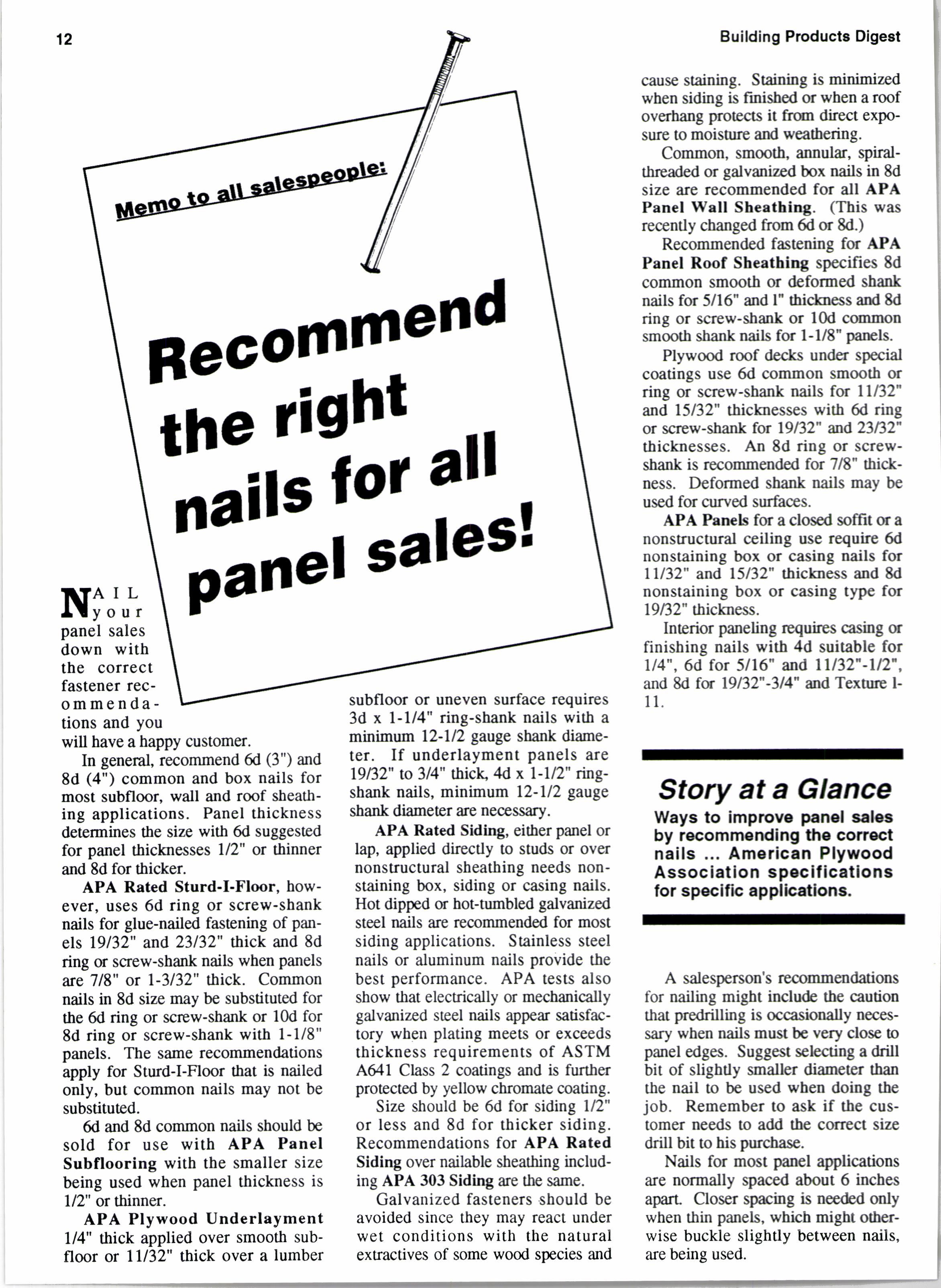
2 minute read
BecomJnend ift" right _ ,;4 ^!#,,\panl
AIL your panel sales down with the correct fastener recommendations and you will have a happy customer.
In general, recommend 6d (3") and 8d (4") common and box nails for most subfloor, wall and roof sheathing applications. Panel thickness detemrines the size with 6d suggested for panel thiclnesses ll2" or thinner and 8d for thicker.
APA Rated Sturd-I-Floor, however, uses 6d ring or screw-sbank nails for glue-nailed fastening of panels 19132" and 23132" thick and 8d ring or screw-shank nails when panels ue 718" or l-3132" thick. Common nails in 8d size may be substituted for the 6d ring or screw-shank or 10d for 8d ring or screw-shank with 1-l/8" panels. The same recommendations apply for Sturd-I-Floor that is nailed only, but common nails may not be substituted.
6d and 8d conmon nails should be sold for use with APA Panel Subflooring with the smaller size being used when panel Oickness is ll2" or thinner.
APA Plywood Underlayment
1/4" thick applied over smooth subfloor or lll32" thick over a lumber subfloor or uneven surface requires 3d x 1-l/4" ring-shank nails with a minimum l2-ll2 gauge sbank diameter. If underlayment panels are 1982" b 314" thiclq 4d x l-l/2" ringshank nails, minimum l2-ll2 gauge shank diameter are necessary.
APA Rated Siding, either panel or lap, applied directly !o studs or over nonstructural sheathing needs nonstaining box, siding or casing nails. Hot dipped u hot-tumbled galvanized steel nails are re@mmended for most siding applications. Stainless steel nails or aluminum nails provide Oe best performance. APA tests also show that electrically or mechanically galvanized steel nails appear satisfactory wben plating meets or exceeds thickness requirements of ASTM A64l Class 2 coatings and is further protected by yellow chromate coating.
Size should be 6d for siding 1/2" or less and 8d for thicker siding.
Recommendations for APA Rated Siding over nailable sheathing including APA 303 Siding are the same.
Galvanized fasteners should be avoided since they may react under wet conditions with the natural extractives of some wood species and
Cause stnining. Staining is minimiztd when siding is fmished or when a roof overbang protecB it fr,m direct exposure to moisore and weatbering.
Comnon, smoo0, annular, spiraltbr€aded or galvanized box naits;n 36 size are recommended for all APA Panel VYall Sheathing. (This was recently changed from 6d c 8d.)
Recommended fastening for APA Panel Roof Sheathing specifies 8d cornmon smooth or deformed shank nails for 5/16" and l" thidoess and 8d ring or screw-shank or l(H crxlrnxrn smooth shank nails for l-l8" parels.
Plywood rmf decks under specid coatings use 6d cornmon smoolh or ring or screw-shank nails for ll8.2 and l5l32 thiclnesses with 6d ring or screw-shank for l9B2 and23B2 thicknesses. An 8d ring or screwshank is recommended for 7l8" thickness. Deforned shank nails may be used for qrved surfaces.
APA Peneb fm a cloced soffit a a nonstructural ceiling use require 6d nonstaining box or casing nails for lll32" nd l5l32 Oickness and 8d nonstaining box or casing type for l9B2 thiclness.
Interior paneling rcquires casing a finishing nails with 4d suitable for 114", 6d for 5/16" md lll32'-ll2', and 8d fu 19132"-314" md Texune l11.
Story at a Glance
Ways to improve panel sales by recommending the correct nails American Plywood Associatlon speclticatlons for speclfrc appl icatlons.
A salespenon's rEcomm€ndations for nailing migbt include tbe caution that predrilling is occasbnally n€cessary when nqil5 6ust be very close to panel edges. Suggest seleaing a drill bit of slightly smaller 6ismeter than the nail to be used when doing tbe job. Remember to ask if the customer needs o add tbe correct size drill bit !o his purcbase.
Nails for most panel ap'plications are normally spaced about 6 inches aparl Closer spacing is nee&d only when thin panels, which might otherwise buckle slightly between nails, are being used.










